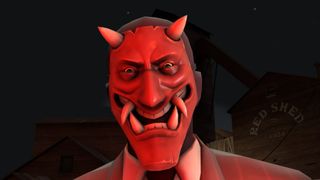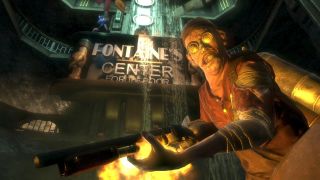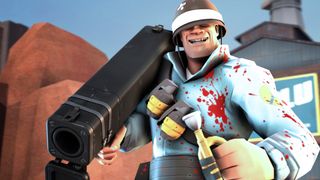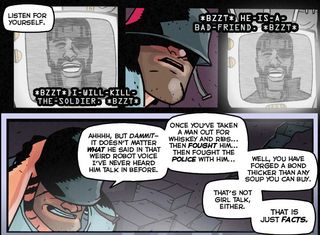How Team Fortress 2 changed FPSes forever
10 years later, multiplayer storytelling is Team Fortress 2's biggest achievement.


Our other anniversary pieces:
- Valve interview
- The Orange Box review from 2007
- Remembering HL2: Episode 2
- Portal and the cake meme
This article was originally published in October 2017. We're repromoting it alongside re-reviews of some of the PC's biggest living games, looking at how they've changed over time.
Not long ago, every first-person shooter had to have a multiplayer mode. Part of multiplayer's job in the late '00s and early '10s was to extend the lifespan of your purchase—to keep Xbox and PlayStation owners' copies in their homes and off of GameStop's second-hand shelves after they finished a six or ten-hour campaign.
It was a dark time for FPS players. We got underwhelming and under-supported multiplayer for games like F.E.A.R, Crysis, Singularity, Prey, Homefront, Far Cry 3, Medal of Honor, Call of Juarez, Duke Nukem Forever, Rage, and Syndicate. In the worst cases, the multiplayer modes of these games contorted the themes and designs into competitive forms. Spec-Ops: The Line lead designer Cory Davis described the multiplayer component of his game years later as "a cancerous growth," saying that "the game mechanics were raped to make it happen, and it was a waste of money."

BioShock 2 multiplayer, incredibly, had seven modes. They were:
– Survival of the Fittest
– Civil War
– Last Splicer Standing
– Turf War
– Capture the Sister
– ADAM Grab
– Team ADAM Grab
– Kill 'em Kindly
One surprise to come out of this era was BioShock 2, which fully embraced the awkwardness of turning the intricate story and setting of Rapture into a deathmatch. You played as one of 10 unique characters living in Rapture at the outset of the civil war. Each had their own backstory, melee weapon art, and loads of custom, situation-specific dialogue that you'd hear during matches (Mlle Blanche de Glace, a French actress, might say "So strange on this side of the camera," when using the Research Camera to earn a damage buff against an enemy). BioShock 2 characters' appearance was tied to their progression—as they leveled up, they'd look more and more like a mutated Splicer, a reflection of their abuse of ADAM. The multiplayer lobby itself was a Rapture apartment, and your character would receive new, unique messages on their answering machine.
The whole thing was framed as a prequel for the first BioShock, grounded in an idea that's only taken hold over the past few years: yes, you can and should put story into a multiplayer FPS.

Talking it out
Credit for killing the trend of tacked-on multiplayer should go to Team Fortress 2. In the 10 years since The Orange Box, Valve's spy-fi FPS has made plenty of contributions to the genre, to Steam, and to the PC. But most significantly, it helped teach the industry, and games like BioShock 2, how to tell stories in competitive multiplayer games.
We take it for granted now, but in 2007, TF2's addition of dozens—eventually hundreds—of situationally-triggered character voice lines was innovative. Without watching a cutscene or reading a dull menu blurb, players would be hit over the head with the idea that the Scout loves baseball ("I'm battin' a thousand!"; "Yo, I oughta' be on a baseball card!"), or that the Soldier is an over-the-top nationalist ("You are now a conscientious objector to being dead, hippie!" after dominating another, apparently lesser Soldier; or "Your white flag does not stop American bullets," to the Spy).
The biggest gaming news, reviews and hardware deals
Keep up to date with the most important stories and the best deals, as picked by the PC Gamer team.
The Spy has his own set of lines that mock the Scout after a kill. I like "May I borrow your earpiece? [mimicking Scout] 'This is Scout! Rainbows make me cry! Over," but the best one has to be "Well, off to visit your mother!" a reference to the canon relationship between Spy and Scout's mom (this literally haunts the Scout's dreams) and a special reward for sticking a knife into the fastest character in the game. We'd see a similar system in Left 4 Dead just a year later.
The voice lines are more than gags: they're economical hits of characterization, taken passively in the breaths between TF2's combat, that lessen the repetition of playing 2fort for the two-thousandth time. One by one, they form a tapestry of connections between TF2's nine classes, reinforcing the hide-and-seek game that Spies and Pyros play, or the symbiotic relationship between the Heavy and Medic.
Some of this is owed to how integrated Valve's writers were into the development of TF2 during this part of the studio's history. "[W]e don’t have a strict wall between design and writing," Valve writer Erik Wolpaw said in 2011. "We’re all together in the same room, designers and writers." You can see the fruits of this integration of writers in TF2's biggest updates, which made new patches not simply 'content,' but richly-themed events led by their fiction, rather than their features.

The massive WAR! update in 2009 solidified the template we'd see for years to come. Even by today's standards, the patch was an avalanche of lore, weapons, new systems, and excitement that made the seven days it lasted a special experience for players. The highlights:
- Kicked off a weeklong contest between Soldier and Demoman players. Via the TF2 wiki: "A kill tracker appeared in the HUD of anybody playing as a Demoman or Soldier, with the counter increasing each time they (as a Soldier) killed an enemy Demoman or they (as a Demoman) killed an enemy Soldier." Whichever side won would earn a new weapon for their class.
- Launched an official Propaganda Contest, calling for fan art (that in turn helped market TF2 to the wider gaming community) focused around the war between Demomen and Soldiers. The winner of the Propaganda Contest, J.Axer, received a one-of-a-kind cosmetic item, a Towering Pillar of Hats with a ribbon pinned to it.
- Six new items, for either the Soldier or the Demoman, were made available.
- Valve published a 21-page comic that formed a backstory for the update: the Demoman and Soldier had become friends, which in the eyes of TF2's in-game announcer, the Administrator, had to be put to an end.
- Published a series of web pages that colorfully housed all the information around this update, which also included easter eggs like the Shakespearicles portrait.
- Oh, and crafting was added.
Framing the addition of a new item as a time-sensitive dramatic event in the TF2 timeline that players themselves had to participate in in order to resolve was a brilliant act of marketing, and we see this concept replicated in competitive games like Overwatch, Destiny 2, CS:GO, and Dota 2. "A secret, exclusive seventh weapon has also been developed by the TF2 team," wrote the TF2 Blog. "In other words, either the Soldier or the Demo (but NOT both) is walking out of this update with one more weapon than the other. If you want your class to have it, you're going to have to fight for it."
The Soldier and the Demo were natural rivals that, up until that point, hadn't had their yin-and-yangness formally expressed. They were both splash-damage classes with different styles: firing parabolically, or firing in a straight line. They could both use their weapons to propel themselves forward. An ordinary sticky bomb kill on cp_well, scored that week, had new meaning, adding to the overall body count.
All of this fun helped to soften the introduction of a new crafting system, laying the groundwork for TF2's item economy. Valve would use this technique again when it introduced paid items and loot crates a year later not as a storefront, but in the form of a fictional character entity: Mann Co. Although it wasn't without controversy and uproar, again, narrative framing and ample humor softened the landing microtransactions made on TF2, a much riskier and more novel concept in 2010 than it is today. You weren't buying items from Valve, you were buying them from a shirtless Australian.
Made to last
It's true that plenty of Team Fortress 2's storytelling has been done outside of its .exe, in comics, short videos, blogs, and marketing imagery. But in widening where its story was being told, Team Fortress 2 broke an old way of thinking, that a singleplayer campaign was the beginning and end of a game's fiction. It's part of the reason we've stopped seeing multiplayer shoehorned into shooters like Prey, Wolfenstein, and Deus Ex.
That approach has produced some of the most well-rounded and memorable multiplayer characters ever, ones that rival protagonists and villains from conventional games. When Blizzard announced Overwatch in 2014, game director Jeff Kaplan said “If people want to compare Overwatch to Team Fortress 2, we would take that as the world’s greatest compliment," said Kaplan. “We love that game; it’s probably one of my favourite games of all time. Those guys are geniuses," he said.
Not many FPSes are being played enthusiastically by a million-and-a-half people 10 years after release. But Quake, Unreal Tournament, Counter-Strike, Rainbow Six, and Battlefield don't have 15-minute short films about fighting giant loaves of mutant bread.

Evan's a hardcore FPS enthusiast who joined PC Gamer in 2008. After an era spent publishing reviews, news, and cover features, he now oversees editorial operations for PC Gamer worldwide, including setting policy, training, and editing stories written by the wider team. His most-played FPSes are CS:GO, Team Fortress 2, Team Fortress Classic, Rainbow Six Siege, and Arma 2. His first multiplayer FPS was Quake 2, played on serial LAN in his uncle's basement, the ideal conditions for instilling a lifelong fondness for fragging. Evan also leads production of the PC Gaming Show, the annual E3 showcase event dedicated to PC gaming.
Most Popular

